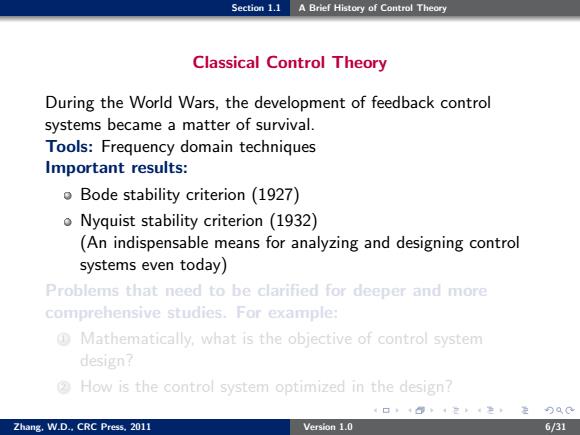
Section 1.1 A Brief History of Control Theory Classical Control Theory During the World Wars,the development of feedback control systems became a matter of survival. Tools:Frequency domain techniques Important results: Bode stability criterion(1927) o Nyquist stability criterion (1932) (An indispensable means for analyzing and designing control systems even today) Problems that need to be clarified for deeper and more comprehensive studies.For example: Mathematically,what is the objective of control system design? How is the control system optimized in the design? 4口+0:4定4生定9QC Zhang,W.D..CRC Press.2011 Version 1.0 6/31
Section 1.1 A Brief History of Control Theory Classical Control Theory During the World Wars, the development of feedback control systems became a matter of survival. Tools: Frequency domain techniques Important results: Bode stability criterion (1927) Nyquist stability criterion (1932) (An indispensable means for analyzing and designing control systems even today) Problems that need to be clarified for deeper and more comprehensive studies. For example: 1 Mathematically, what is the objective of control system design? 2 How is the control system optimized in the design? Zhang, W.D., CRC Press, 2011 Version 1.0 6/31
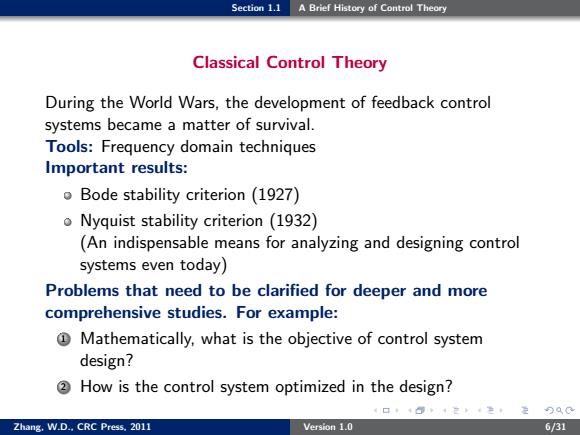
Section 1.1 A Brief History of Control Theory Classical Control Theory During the World Wars,the development of feedback control systems became a matter of survival. Tools:Frequency domain techniques Important results: Bode stability criterion(1927) o Nyquist stability criterion (1932) (An indispensable means for analyzing and designing control systems even today) Problems that need to be clarified for deeper and more comprehensive studies.For example: Mathematically,what is the objective of control system design? 2 How is the control system optimized in the design? Zhang,W.D..CRC Press.2011 Version 1.0 6/31
Section 1.1 A Brief History of Control Theory Classical Control Theory During the World Wars, the development of feedback control systems became a matter of survival. Tools: Frequency domain techniques Important results: Bode stability criterion (1927) Nyquist stability criterion (1932) (An indispensable means for analyzing and designing control systems even today) Problems that need to be clarified for deeper and more comprehensive studies. For example: 1 Mathematically, what is the objective of control system design? 2 How is the control system optimized in the design? Zhang, W.D., CRC Press, 2011 Version 1.0 6/31
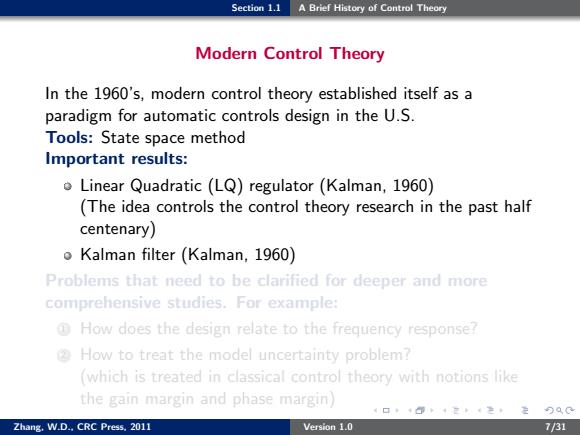
Section 1.1 A Brief History of Control Theory Modern Control Theory In the 1960's,modern control theory established itself as a paradigm for automatic controls design in the U.S. Tools:State space method Important results: Linear Quadratic (LQ)regulator(Kalman,1960) (The idea controls the control theory research in the past half centenary) oKalman filter (Kalman,1960) Problems that need to be clarified for deeper and more comprehensive studies.For example: How does the design relate to the frequency response? How to treat the model uncertainty problem? which is treated in classical control theory with notions like the gain margin and phase margin 4口,4心4定4生,定QC Zhang.W.D..CRC Press.2011 Version 1.0 7/31
Section 1.1 A Brief History of Control Theory Modern Control Theory In the 1960’s, modern control theory established itself as a paradigm for automatic controls design in the U.S. Tools: State space method Important results: Linear Quadratic (LQ) regulator (Kalman, 1960) (The idea controls the control theory research in the past half centenary) Kalman filter (Kalman, 1960) Problems that need to be clarified for deeper and more comprehensive studies. For example: 1 How does the design relate to the frequency response? 2 How to treat the model uncertainty problem? (which is treated in classical control theory with notions like the gain margin and phase margin) Zhang, W.D., CRC Press, 2011 Version 1.0 7/31
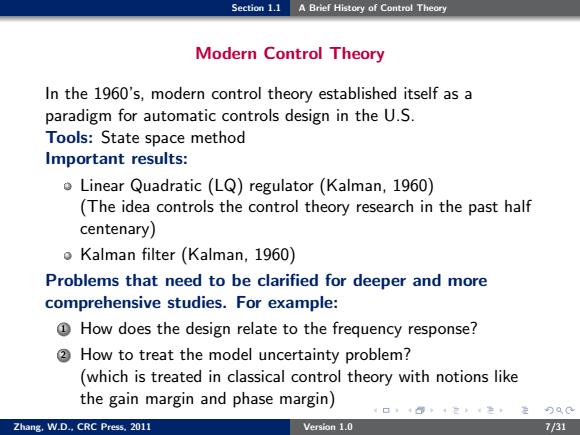
Section 1.1 A Brief History of Control Theory Modern Control Theory In the 1960's,modern control theory established itself as a paradigm for automatic controls design in the U.S. Tools:State space method Important results: Linear Quadratic (LQ)regulator(Kalman,1960) (The idea controls the control theory research in the past half centenary) o Kalman filter (Kalman,1960) Problems that need to be clarified for deeper and more comprehensive studies.For example: 1How does the design relate to the frequency response? 2How to treat the model uncertainty problem? (which is treated in classical control theory with notions like the gain margin and phase margin) Zhang.W.D..CRC Press.2011 Version 1.0 7/31
Section 1.1 A Brief History of Control Theory Modern Control Theory In the 1960’s, modern control theory established itself as a paradigm for automatic controls design in the U.S. Tools: State space method Important results: Linear Quadratic (LQ) regulator (Kalman, 1960) (The idea controls the control theory research in the past half centenary) Kalman filter (Kalman, 1960) Problems that need to be clarified for deeper and more comprehensive studies. For example: 1 How does the design relate to the frequency response? 2 How to treat the model uncertainty problem? (which is treated in classical control theory with notions like the gain margin and phase margin) Zhang, W.D., CRC Press, 2011 Version 1.0 7/31
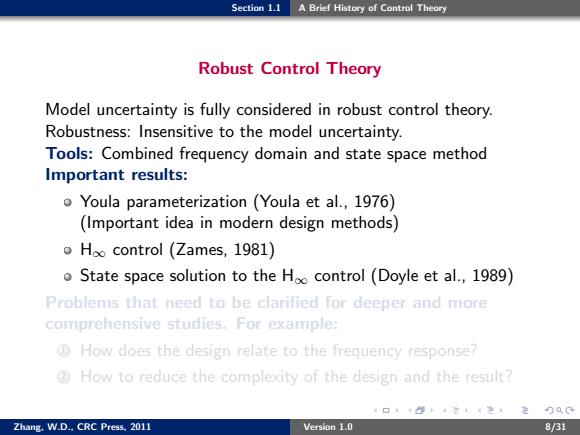
Section 1.1 A Brief History of Control Theory Robust Control Theory Model uncertainty is fully considered in robust control theory. Robustness:Insensitive to the model uncertainty. Tools:Combined frequency domain and state space method Important results: Youla parameterization (Youla et al.,1976) (Important idea in modern design methods) Hoo control (Zames,1981) State space solution to the Hoo control(Doyle et al.,1989) Problems that need to be clarified for deeper and more comprehensive studies.For example: How does the design relate to the frequency response? How to reduce the complexity of the design and the result? 4口,+@4定4生定QC Zhang.W.D..CRC Press.2011 Version 1.0 8/31
Section 1.1 A Brief History of Control Theory Robust Control Theory Model uncertainty is fully considered in robust control theory. Robustness: Insensitive to the model uncertainty. Tools: Combined frequency domain and state space method Important results: Youla parameterization (Youla et al., 1976) (Important idea in modern design methods) H∞ control (Zames, 1981) State space solution to the H∞ control (Doyle et al., 1989) Problems that need to be clarified for deeper and more comprehensive studies. For example: 1 How does the design relate to the frequency response? 2 How to reduce the complexity of the design and the result? Zhang, W.D., CRC Press, 2011 Version 1.0 8/31